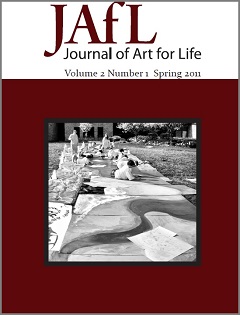Bringing Art to Life through Multiple Perspectives: Pre-Service Art Educators and Social Justice
Keywords:
pre-service education, social justice, multiculturalism, Beayeux tapestry, Iraq war imageryAbstract
Three socially-conscious education constructs are presented as they emerged from a meaningful pre-service art education project and the student discussion that followed. Teaching and learning approaches are illuminated through a studio assignment in a secondary art education pre-service methods course. The pictorial narrative of the historical Beayeux tapestry, when compared with more recent images associated with the Iraq war, led to the creation of a contemporary 27-foot tapestry. The author dissects both the intellectual, emotional experiences of the students and the learning outcomes that were evoked by this collaborative assignment. Through her reflections, the author demonstrated an approach to education that is essential for pre-service educators; the need to teach from a multicultural perspective, to teach strategies for dealing with controversial issues, to tactfully and respectfully diffuse emotionally charged content, and to encourage social change are requirements of teaching in today’s classroom. This pedagogical approach is supported by current educational research and discourse.Downloads
Published
2011-03-15
Issue
Section
Articles
License
Authors who publish with this journal agree to the following terms:- Authors retain copyright and grant the journal right of first publication with the work simultaneously licensed under a Creative Commons Attribution License that allows others to share the work with an acknowledgement of the work's authorship and initial publication in this journal.
- Authors are able to enter into separate, additional contractual arrangements for the non-exclusive distribution of the journal's published version of the work (e.g., post it to an institutional repository or publish it in a book), with an acknowledgement of its initial publication in this journal.
- Authors are permitted and encouraged to post their work online (e.g., in institutional repositories or on their website) prior to and during the submission process, as it can lead to productive exchanges, as well as earlier and greater citation of published work (See The Effect of Open Access).


